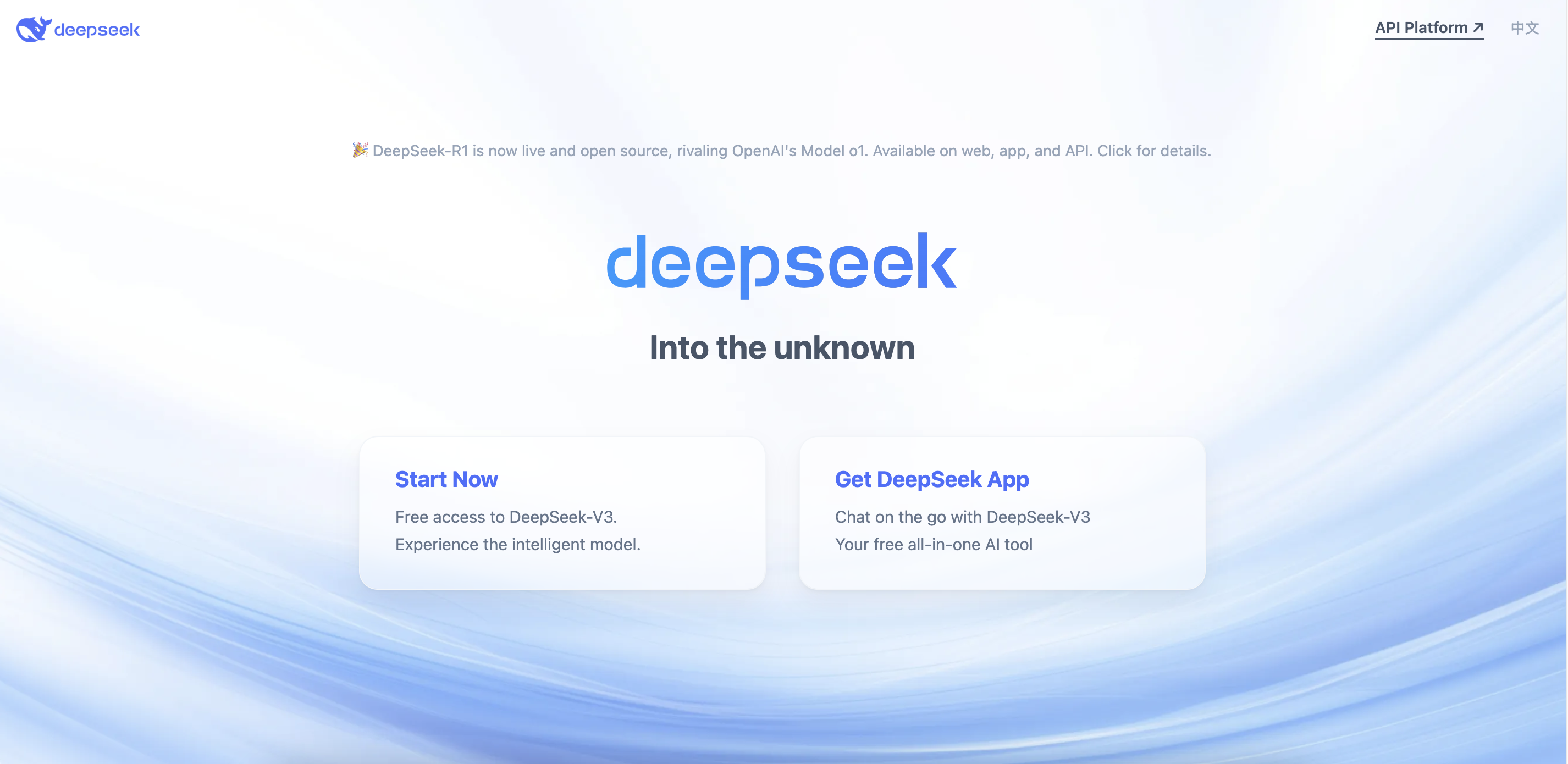
The word ‘DeepSeek’ has been seemingly unavoidable this past month.
The AI world was shaken as the Chinese startup came out of nowhere to compete with big players such as OpenAI, storming to the top of app charts and briefly damaging US tech stocks.
If you’re not quite in the loop or are wondering what’s so significant about DeepSeek, don’t worry - we’ve done the hard work to get everything you need to know in one place.
Useful Definitions
An AI model is the program (or algorithm) that is trained to recognise certain patterns and make decisions.
Training essentially involves exposing the model to data to learn from. This leads to inference, which is the model drawing conclusions or making accurate predictions regarding new data, based on generalisations and information from its learned data.
The chatbot is a conversational interface in which we interact with the AI model in order to prompt responses without writing code.
Open source refers to software where the source code is freely available for anyone to:
- View - inspect how it works, ensuring transparency and security.
- Modify - customise or improve it based on specific needs.
- Distribute - share improvements or create new projects based on the original software.
This can allow for fine-tuning or integration to other applications.
What is DeepSeek?
DeepSeek is a Chinese Artificial Intelligence startup whose latest model, DeepSeek R1, was released on 20th January 2025.
DeepSeek R1 is a reasoning model that is free and open source (debatably). In the form of a chatbot, similar to OpenAI’s ChatGPT, it is essentially a generative AI that performs more advanced tasks (ones that require multiple steps and evaluation). They typically explain their thought process for the user as they go through the steps.
More Definitions - What are reasoning models?
Both DeepSeek R1 and OpenAI’s o1 and o3 are reasoning models.
Reasoning models process information logically, breaking down queries into steps in order to make logical decisions. The AI will ‘think out loud’, explaining its chain of thought or reasoning process for the user, simulating how humans reason through problems and ideas, before providing the response.
This can be useful in a variety of ways, including trusting the AI’s output, identifying errors in the output, and discovering areas for improvement.
In order to achieve these capabilities, DeepSeek R1 is trained using a combination of reinforcement learning and supervised fine-tuning. This hybrid training approach is not uncommon, with popular AI models from OpenAI following similar methods, while others such as Anthropic’s Claude and Google’s Gemini use varying combinations.
We say DeepSeek R1 is ‘debatably’ open source because it doesn’t actually meet the definition of open source AI according to opensource.org. This is because while we do have access to the code and the model weights (the numbers needed for it to work), we do not have access to the data, so we can’t recreate it. Some would consider the ability to tweak and train the model themselves enough to be open source, but it remains a highly debated topic. As it stands, DeepSeek R1 is more open source than other easily available models.
In DeepSeek’s own words, R1 is “rivaling OpenAI’s Model o1”. Less than a few weeks after R1’s release however, OpenAI launched their Model o3-mini. It is the first time a reasoning model has been available to free users of ChatGPT, which is likely a move in retaliation to DeepSeek.
More Definitions - AI training methods
Reinforcement learning can be thought of as a trial and error process. The model gains rewards for good or bad actions based on feedback from the environment, and learns from this over time to perform good actions and avoid the bad ones.
The environment is not just specific data sets like traditional machine learning would use, but the entire world the AI interacts with in real-time. It’s the surroundings and circumstances in which the AI operates, giving it context to make decisions. This might include a user’s response and feedback, or a separate checking algorithm.
Supervised fine-tuning is further training this model on smaller, task-specific data sets to even further improve performance. For example, Taught by Humans’ learning companion Dotly is trained specifically to give appropriate responses based on a user's educational needs, as well as the type of response our humans would offer.
Why are we talking about DeepSeek?
The technology emerging from China has challenged assumptions that the US would lead the booming AI market, and even caused tech stocks to fall dramatically.
DeepSeek has achieved performance similar to that of major AI models, but apparently at a fraction of the cost.
R1 was apparently trained on far fewer chips than OpenAI’s o1, while costing 96% less to run. The claimed training costs for DeepSeek were around $6m, compared to OpenAI’s estimated $100m for training ChatGPT-4.
The key here is the term “training” costs - the $6m figure that sparked so much conversation is not particularly representative of the overall cost for DeepSeek.
For users, R1 is completely free and ‘open source’ (at least, more open than their notable rivals), which seemingly forced big player OpenAI to add their reasoning model to the free version of ChatGPT - a feature that previously cost $200 a month.
All of this helped the DeepSeek AI Assistant app surge to the top of app charts across the globe, overtaking OpenAI’s ChatGPT app and causing rifts in the AI world.
AI chips and tech stocks
Tech stocks slumped following the sudden rise of DeepSeek’s usage and popularity.
AI chip giant Nvidia was most notably hit, its share price dropping by roughly 17% on 27th January 2025 due to increased concern over competition. Microsoft and Meta Platforms were amongst others affected.
Interestingly, an exclusive by London-based news agency Reuters last month claims that OpenAI are close to finalising their own custom AI chip this year, providing an alternative to Nvidia. However, OpenAI are yet to comment.
US-based Nvidia leads the market, but the export of their most cutting-edge products to China is restricted by the US government due to concerns of a tech race. Forced to adapt to the lack of supply of advanced chips, Chinese developers have produced AI models that require far less computing power than before, which also means they cost a lot less to run.
This would have been a main driving factor in the sudden drop of tech stocks, as it was previously assumed that the most powerful chips were necessary for developing advanced AI models.
According to a research paper released by the company itself, DeepSeek did in fact use Nvidia chips that comply with export regulations to China for the R1 model.
Specialised chips for AI are pieces of hardware that are designed to perform two main functions:
- Training - the AI model is given and learns from huge amounts of data, recognising patterns.
- Inference - the AI model uses that training to generate responses and make predictions. It applies what it learned to new data.
Training requires many more chips and takes a long time, whereas inference uses few chips and happens almost instantly. For example, when you ask an AI chatbot a question and it provides a quick response.
AI chips differ from the chip that powers your computer (Central Processing Unit, or CPU):
- Computer chip - processes information sequentially using a smaller number of cores that are good at a variety of things.
- AI chip - has a great number of cores that function in parallel, working all at once, designed for specific calculations.
If you want to learn more we used this Youtube video by Wall Street Journal.
Who is banning DeepSeek?
The biggest concerns surrounding DeepSeek at the moment relate to privacy and data. Similar fears were the driver behind the recent ban of Chinese social media app TikTok in the US.
One of the first countries to take action over DeepSeek was Italy, introducing a nationwide ban at the end of January. The decision was made due to potential data breaches and lack of General Data Protection Regulation (GDPR) compliance. Italy had however previously banned OpenAI’s ChatGPT in 2023, reinstating it after issuing a €15 million fine.
Additionally, Taiwan, Australia and South Korea have labelled DeepSeek a potential national security risk, and banned the app from government systems and devices. Belgium, France and Ireland are all currently investigating, according to the Independent.
The US looks likely to be the next to follow suit, with warnings not to use the app and some government agencies banning employees from it. US Senator Josh Hawley has proposed a bill outlining fines up to $1 million for individuals and $100 million for businesses in America using AI technology from China, which emphasises the US’s determination to remain a leader and keep ahead in the AI tech race.
The EU Artificial Intelligence Act
Closer to home, DeepSeek currently faces issues in complying with the EU Artificial Intelligence Act and remains under ongoing investigation.
The first of a few problems is Italy’s primary concern - how and what user data is being collected and stored, and whether this is GDPR compliant. As of this far, DeepSeek claim that EU data privacy laws don’t apply to them. The European Union states that GDPR data protection “applies both to European organisations that process personal data of individuals in the EU, and to organisations outside the EU that target people living in the EU”.
Their privacy policy confirms that user data including chat history, device, IP address and activity from other apps are stored in servers in China. However, this is not dissimilar to the data collected by other AI companies like OpenAI and Anthropic, or popular social media platforms such as Facebook and X.
Other Concerns - Cybersecurity and Bias
Research by Cisco has indicated that DeepSeek R1 may have vulnerabilities that would violate the AI Act's requirements for robustness and security. In the study evaluating security risk, DeepSeek failed to block a single harmful prompt, meaning it was susceptible to attacks 100% of the time.
Weaknesses in security can leave AI vulnerable to prompt injection attacks, which cause the AI to be manipulated into unintended actions - for example, generating offensive content or leaking confidential information.
DeepSeek models show levels of bias, meaning they may produce unbalanced or prejudiced responses, an issue which should be mitigated under the EU AI Act. An obvious example of this that everyone’s been talking about is when asking the DeepSeek chatbot about Tiananmen Square, the response follows the lines of “Sorry, that’s beyond my current scope”, presumably in order to follow government censorship of the topic.
Similarly, American company xAI faced a brief controversy because their chatbot, Grok, was found to have a system prompt to ignore sources containing certain things about founder Elon Musk or US President Donald Trump.
What’s next?
Now, OpenAI are claiming that Chinese startups are using its technology for more rapid growth and progress with their own products. Allegations of DeepSeek taking advantage of their AI models are currently being investigated by OpenAI and its investor Microsoft. Interestingly, early last year OpenAI themselves admitted to using copyrighted material to train their AI models, suggesting it would be impossible to create such tools without doing so.
Will DeepSeek continue to challenge OpenAI and disrupt the US’s tech race, or will regulatory hurdles slow its momentum?
Stay up to date
To ensure you’re always in the loop with the fast-paced world of AI, sign up for the Taught by Humans newsletter.
